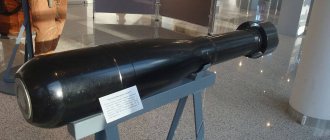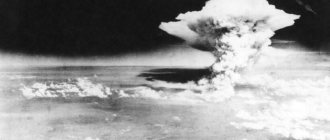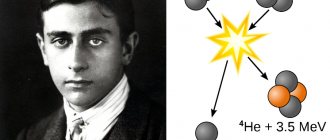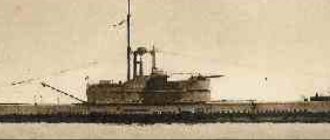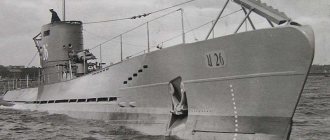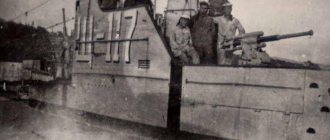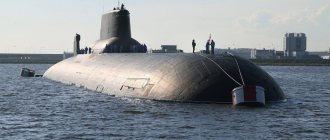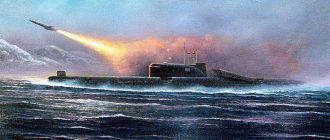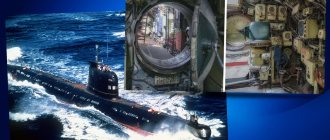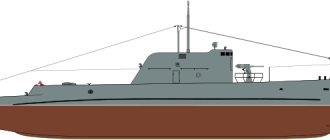Even Leonardo da Vinci, the greatest figure of the Renaissance, pondered the concept of a submarine. This boat, according to the sketches that have reached us, was supposed to be a hull with a pointed turret and a wheelhouse. Only one sailor could be inside the submarine. Da Vinci believed that the only purpose of such a boat was to sink enemy ships. The sailor operating it had to approach the enemy ship in the harbor, attach a strong cable to the ship's hull, and send its other end with a heavy sinker to the bottom. And when the ship starts moving, its skin will come off and it will lose its watertightness.
But da Vinci subsequently abandoned this project. It did not become a reality, and therefore it is a stretch to call the titan of the Renaissance the inventor of the submarine...
Submarine Leonardo
Among the inventions of the legendary Leonardo da Vinci , who worked at the end of the 15th and beginning of the 16th centuries, there is also a submarine project.
Article on the topic From tank to submarine. 10 inventions of Leonardo da Vinci
According to his drawings, it was a hull with a pointed turret and a wheelhouse where only one person could be located. The scientist created a submarine solely for the purpose of sinking enemy ships. A sailor on a submarine had to quietly sneak up on an enemy ship in a port, attach a special cable to the hull of the ship, and throw the other end of the cable with a load onto the seabed. When the ship moved from its place, the plank lining came off due to the load, and the ship sank. It is curious that among the Italian’s inventions there were also a diving suit and a breathing apparatus for scuba diving. However, these inventions of da Vinci remained unclaimed.
The submarine was designed to sink enemy ships. Photo: AiF/ Yana Khvatova
A wonderful weapon that can change the course of a war
The Russo-Japanese War had been going on for more than six months, and it was not developing at all as the Russian generals and admirals had expected and would have liked. The main forces of the Russian fleet in the Pacific Ocean were blocked in Port Arthur and partially in Vladivostok. Japanese battleships, cruisers and destroyers dominated the sea, and an unlimited mine war began, which quickly brought stunning results. Large, well-armed warships and transports carrying military cargo and troops were blown up by minefields and sank in a matter of minutes.
And, as often happens in days of heavy defeats, military thought began to work. The search began for the Wunderwaffe - a wonderful new weapon that could radically change the course of the war. Such a weapon could be a submarine, secretly approaching the enemy fleet, laying secret minefields, firing a deadly torpedo from an ambush. Old people tend to believe in miracles, and the elderly admirals of the Russian fleet were no exception.
Bunkering (refilling with fuel and motor oils) of a submarine
Image from the collection of P. Kamenchenko
By the beginning of autumn 1904, six boats were built at the Baltic Shipyard according to the design of Bubnov and Beklemishev. They received the following names: “Killer whale” (the lead boat of the series), “Skat”, “Burbot”, “Mackerel”, “Perch” and “Field Marshal Count Sheremetev”. A significant part of the funds for the construction of the latter was provided by the Sheremetev family. Six more submarines with fish names based on Holland’s design - “Pike”, “Sterlet”, “Gudgeon”, “Beluga”, “Salmon” and “Pike-perch” - were ordered from the Nevsky Shipyard. In addition, a boat was purchased from Holland, which received the name “Catfish”.
In October 1904, Bubnov designed a 16-axle railway transporter for transporting submarines to the Far East. By mid-December, “Kasatka”, “Skat”, “Burbot”, “Field Marshal Count Sheremetev”, “Dolphin”, “Sturgeon” and “Catfish” were transported to Vladivostok, covering a distance of about 10 thousand kilometers. This was the world's first transportation of submarines with a displacement of more than 100 tons by rail.
"Bubot" on a transport railway platform. November 1904
Image from the collection of P. Kamenchenko
From the delivered submarines, a “Separate Detachment of Destroyers” was formed, which became part of the Cruiser Detachment of the Pacific Fleet. "Catfish" was launched on January 3, "Dolphin" - on the 14th, but the boats could not begin combat operations, since torpedoes were not brought to the war. While waiting for armament, the boat practiced diving in the roadstead. The torpedoes arrived only on March 29, 1905. It took twice as long to deliver them as it did to transport the boats.
Drebbel's submersible
The inventor of the first operational submarine is considered to be the Dutchman Cornelius Drebbel . In 1620, while working for the English navy, Drebbel built a submarine made of wood covered with leather. He used the theoretical work of William Bourne , published 40 years earlier.
Drebbel managed not only to build several prototype submarines, but also to successfully test them in the waters of the Thames in front of King James I.
The most advanced version of Drebbel's submarine could remain submerged for several hours, with up to 16 people on board. The boat made a successful passage from Westminster to Greenwich and back. However, the British Admiralty considered that such a ship could not be useful to the fleet.
Demonstration of Drebbel's submarine, Thames, 1620 Photo: Commons.wikimedia.org
Submariner's Day
The results of the use of submarines during the war with Japan and the future prospects of this type of weapon in the Russian fleet were discussed in the report of the Main Naval Staff: “Looking at the reasons why ships located in the Far East, and especially combat ones, are in such an unsatisfactory condition, it follows admit that the main reason for this is the lack of organization of courts into tactical units, and as a consequence of this, the absence of the necessary commanders.”
The combat qualities of the submarines in service were also greatly questioned. And although the use of the new miracle weapon in the Far Eastern theater of operations was considered completely unsatisfactory, the prospects for the submarine fleet as a whole were assessed very highly. A number of decisions were made to further improve the boats and train submariners.
On March 19, 1906, Emperor Nicholas II signed a decree on the inclusion of submarines in the classification of ships of the military fleet of the Russian Empire. This date is celebrated in Russia as Submariner Day.
The submarine "Skat" (of the "Kasatka" project) installs torpedoes. 1905
Image from the collection of P. Kamenchenko
“The Hidden Vessel” by Efim Nikonov
In 1718, Efim Nikonov , a carpenter from the village of Pokrovskoye near Moscow, filed a petition addressed to Peter I , in which he stated that “for a military event, he will make a ship suitable for the enemies, with which at sea, in quiet times, he will break up at least ten ships , or twenty, and for testing that ship he will make a sample of how many guns it will have, under the loss of its belly, if it is not desired.”
The Russian Tsar, who was interested in various technical innovations, had a conversation with Nikonov, became convinced that the project was quite serious, and instructed the Admiralty Board to engage in the practical implementation of the plan.
Article on the topic
Fashion for progress. Inventions that made Russia popular and changed the world Only rough descriptions of Efim Nikonov’s submarine have been preserved. Its length was no more than 6 meters, height - 1.5-2 meters. The shape resembled a flat-bottomed ship with a sealed upper deck. 10 tin plates with through holes were embedded in the body to receive water during immersion. This water ballast was taken in leather bags. During the ascent, water was pumped overboard manually using a copper piston pump. An airlock chamber with a hatch was made in the hull for the diver to exit the submerged boat. It was assumed that if the tests were successful, a rowing engine would be installed on the boat. Nikonov also developed a diving suit, which was intended for a saboteur swimmer emerging from a boat in a submerged position to destroy enemy ships.
The first tests of the “hidden ship” took place in 1724 and ended in failure: the boat quickly sank to the bottom, the hull was damaged by the impact, resulting in flooding. They managed to save the inventor who was on board.
Peter I was not disappointed in the plan and ordered Nikonov to continue the work. However, new tests also failed.
After the death of the Tsar in 1725, officials of the Admiralty Board lost interest in the “hidden ship” project. In 1728, work was stopped, and the inventor himself was sent to the Astrakhan shipyards as an ordinary carpenter.
Model of the “hidden ship” in Sestroretsk. The test of the “hidden ship” took place in 1721 in the presence of Peter I on the Neva River near the Galerny Dvor. Photo: Commons.wikimedia.org
“Well, thank God, we swam underwater...”
In December 1900, the Russian Maritime Department created a commission to develop a submersible vessel for coastal defense, codenamed Destroyer No. 113. The construction of the first domestic submarine was supervised by Ivan Grigorievich Bubnov, a naval engineer, teacher at the Nikolaev Maritime Academy, and designer at the Baltic Shipyard.
The gasoline engine was ordered from Germany, the batteries and electric motor were ordered from France, the sheet steel was made at the Putilov plant, and the tanks were made at Obukhovsky. The work was carried out at the Baltic Shipyard in complete secrecy. The cost of the vessel was initially estimated at 220 thousand rubles.
In the summer of 1901, Russian engineers visited Holland's shipyards in the United States and even took part in one of the experimental dives. Upon return, the project was finalized and in May 1903 it was launched as destroyer No. 150.
Mikhail Beklemishev was appointed the first captain, the team consisted of ten people - two officers and eight sailors. The first dive ended with a hit to the bottom, but the boat was not damaged and surfaced on its own. Having climbed onto the deck, Beklemishev crossed himself and said: “Well, thank God, we swam under water...”.
On August 16, “Destroyer No. 150” was inspected by Emperor Nicholas II himself. I didn’t understand much, but I was pleased. Bubnov was awarded 24 and a half thousand rubles as an incentive, Beklemishev received 19 and a half thousand.
Alterations and improvements continued. The resulting riveted hull made of high-strength nickel steel was sheathed on the outside with two layers of larch and covered with galvanized iron. The tanks were filled with water by gravity, and purged using compressed air, to replenish the reserves of which there was an electric compressor. A surface speed of nine knots was provided by a six-cylinder gasoline engine producing 300 horsepower. An electric motor of 120 horsepower made it possible to produce up to six knots under water.
The submarine was armed with two external torpedo tubes of the Drzewiecki system, which were loaded with Austrian Whitehead torpedoes with a range of up to one and a half kilometers.
The length of the boat was 19.6 meters, the greatest width was 3.59, the average depth was about 3 meters, the surface displacement was 113 tons, the underwater displacement was about 123. The inside of the boat was very cramped and extremely inconvenient for maintenance and repair.
"Dolphin" near the wall of the Baltic Shipyard. 1903
Image from the collection of P. Kamenchenko
Bushnell's "Turtle"
In 1775, American David Bushnell created a design for a combat submarine called the Turtle. The length of the vessel was 2.3 m, height - 1.8 m, width - 0.9 m. The hull consisted of two wooden shells covered with tar. Immersion and ascent were ensured by the operation of a hand pump, which pumped in and out water (which was used as ballast) from the tanks, movement - thanks to screws driven by muscular force. In addition, a lead tear-off weight was placed under the hull of the boat, serving as ballast and used for emergency ascent.
The submarine was designed for one person. The supply of breathing air was calculated for half an hour of scuba diving.
Bushnell, who had proven that gunpowder exploded underwater, created a time bomb, and with the help of two of his inventions intended to attack the British ships blockading New York Harbor during the Revolutionary War.
On September 7, 1776, volunteer sergeant Ezra Lee attempted to attack the British flagship on the Turtle, but was unable to attach a mine to the side of the ship.
During the second attack attempt, the British ships discovered the ship towing the Turtle, destroying both it and the submarine.
Reconstruction of "Turtle". Royal Navy Submarine Museum (Gosport, UK) Photo: Commons.wikimedia.org
Submarines of the First World War
Submarines, at the end of the 19th century. almost included in the list of prohibited weapons, they proved their effectiveness from the very beginning of the First World War. Already on September 5, 1914, a German submarine torpedoed the British cruiser Pathfinder, and on September 22, the submarine U-9 distinguished itself, sinking 3 British cruisers in a matter of minutes. In the following months of unrestricted submarine warfare, German submarines nearly brought England to its knees by blocking maritime trade.
German submarine U-9 - warship of the First World War
The U-9 submarine of the 1910 model was one of the first German submarines. It had a displacement of 611 tons, a crew of 25 people, and was armed with 4 torpedo tubes of 450 mm caliber.
In 1914, another German submarine, U-35, was put into operation. The submarine with a displacement of 971 tons was armed with four 500-mm torpedo tubes (2 bow and 2 stern), the reserve was 6 torpedoes. During its service (until 1918), the boat made 19 military campaigns, during which it sank enemy ships (mostly merchant ships) with a displacement of more than 500,000 tons.
German combat submarine U-35, 1914
In 1916, an unusual ship launched from the stocks of the Kiel shipyard “Deutsche Werke”. It was the world's first merchant submarine, the Deutschland, with a displacement of about 2,000 tons. Germany did not build such ships because of a good life: all surface trade was blocked by the British fleet. However, in 1917, the Deutschland passed into the hands of the German Navy and, by installing two torpedo tubes, was converted into a combat submarine.
The British responded by creating K-type boats - real submarine cruisers with a displacement of 2,800 tons. For surface travel, they used steam turbines with a capacity of 10,000 hp. With.! Such formidable ships allowed England to effectively fight German submarines.
In total, during the war, about 600 submarines of the warring states sank 55 large surface ships (battleships, cruisers and auxiliary cruisers), 105 destroyers and 33 submarines (11% of the number killed during the war). During the war, German submarines sank 5,861 merchant ships with a total cargo capacity of 13.2 million tons. During the fighting, 178 (48%) of 372 German submarines were lost.
The submarine "Deutschland" of the German Navy was originally built as a commercial vessel
British submarine K-22 series "K" from the First World War
How can one boat decide the outcome of a war?
The German World War I submarine U-20 was launched in 1912. The submarine became infamous. On May 7, 1915, he sank the British passenger liner Lusitania by mistake. Citizens of the United States of America, a state that had until then maintained military neutrality, died. This pushed the United States to enter the war against Germany, which dramatically changed the course of the war against the Germans.
"Nautilus" by Robert Fulton
In 1800, the American inventor Robert Fulton , creator of one of the first steamships, inspired by the work of Bushnell, began building a submarine of his own design, which he was going to offer to Napoleon.
The boat, called the Nautilus, was successfully tested in Le Havre harbor in 1801.
The hull of the boat was made of wood with metal structures, lined with copper sheets. When on the surface, the boat was sailing; when underwater, it was propelled by the muscular strength of the crew. The boat was armed with a mine towed on a cable.
In total, Fulton built three modifications of the Nautilus, but Napoleon was not interested in the submarine projects. The inventor offered the Nautilus to the English fleet, but the British also considered such a development useless.
Fulton's submarine design, 1806 Photo: Commons.wikimedia.org
Post-war diesel-electric submarines
After the end of World War II, the development of submarines was strongly influenced by the achievements of the German Navy. The German Kriegsmarine managed to develop very effective underwater vehicles, but, fortunately for the allies, it was no longer possible to put them into service and use them for their intended purpose.
Project 877 combat submarine (Varshavyanka type) of the Russian Navy
Soviet designers, based on the German submarine of the XXI series, developed a Project 613 boat with a displacement of 1350 tons. Its power plant consisted of two diesel engines and electric motors. Armament included 4 bow and 2 stern 533 mm torpedo tubes. Underwater, the boat developed a speed of up to 13.1 knots, and on the surface - up to 18.3 knots. The command of the USSR Navy planned to build 340 such boats at once. From 1950 to 1957, 215 units were produced, which became a record number of serial production of submarines in the domestic shipbuilding industry.
Around the same time, a larger boat of Project 641 was developed in the Soviet Union. This submarine with a displacement of 1950 tons was armed with 10 torpedo tubes (6 bow and 4 stern) of 533 mm caliber. Ammunition was 22 torpedoes or 32 mines. A total of 75 such submarines were built.
Soviet submarine project 641
The new German Project 212 boats are equipped with a hybrid propulsion system. Batteries are used underwater, and a traditional diesel generator is used for floating on the surface. The boat has a displacement of 1830 tons. Underwater it can travel at a speed of up to 20 knots, and its surface speed is 14.2 knots. The armament consists of 6 torpedo tubes.
Soviet/Russian submarines of Project 877 Varshavyanka and similar boats of Projects 636 and 677 are in high demand on the world arms markets.
Project 613 submarine of the Soviet Navy
About 50 boats were manufactured under Project 877. They have a displacement of 3950 tons and are equipped with a power plant with a capacity of 3750 hp. With. The underwater speed reaches 17 knots, the surface speed is 10 knots. The armament consists of 6 torpedo tubes.
It should be noted that, along with traditional torpedo weapons, many modern diesel-electric submarines also have missile weapons, with cruise and anti-ship missiles launched from standard torpedo tubes.
Submarine number U-31 of project 212 of the German Navy
From 1990 to 2003, 6 Collins-class diesel-electric submarines were built - the only type of submarine of the Australian Navy. These submarines, with a displacement of 3,353 tons, are real giants among their diesel-electric classmates. Their armament consists of 6 bow 533-mm torpedo tubes with an ammunition capacity of 22 torpedoes. Instead of torpedoes, Harpoon missiles (ammunition 22 missiles) or mines (44 pieces) can be used.
Thus, over the course of half a century, the submarine has transformed from a craft capable of only going under water for a short time into a perfect warship. Such a vessel is capable of staying under water for a long time, moving at high speed and hitting targets not only at sea, but also on land.
Australian Navy Collins-class submarine
"Hunley": the story of the first submarine that sank a warship
In the United States, during the Civil War, combat submarine projects were developed by representatives of the Confederacy, who were trying to find effective counteraction to the northern fleet.
During the war, projects were carried out in extreme haste, which led to the death of crews during testing.
In 1863, the inventor Horace Hanley , who had previously had several attempts to create submarines behind him, designed a boat that had several names, but was later better known by the name of the inventor - “Hunley”.
Article on the topic
"Save our souls." The true story of the accident on the K-19 submarine. It was a steel “cigar” almost 12 meters long and 1.17 m wide. At the ends of the boat there were two ballast tanks, filled through valves and drained by hand pumps. There was also additional ballast in the hull, which provided stability: metal weights attached to the bottom of the hull. For an emergency ascent, these weights could be detached by unscrewing the bolts from inside the boat.
The crew consisted of eight people: an officer-commander and seven sailors-oarsmen.
The boat was armed with a pole mine containing more than 40 kg of gunpowder, attached to an almost seven-meter pole mounted in the bow.
Tests of the Hanley went with varying degrees of success. At first, they managed to successfully blow up an old ship that was serving as a training target. However, following this, the boat, returning to base, suddenly sank, killing five people. Three crew members managed to escape.
Article on the topic
Baltic "Varyag". A diver about how they found the heroically dead submarine. Two weeks later, the submarine was raised, put in order, and new tests were led by Horace Hanley himself. A successful attack on a training target was carried out again. But four days later, the Hanley sank just 450 meters from the shore and did not surface. As it turned out, due to technical imperfections in the design and inconsistency in the actions of the crew, the Hanley, having sank to the bottom, lost the ability to surface. The boat was raised three weeks later. It turned out that it remained sealed, and the entire crew, including the inventor, died from suffocation.
Despite all this, on February 17, 1864, Hunley, under the command of First Lieutenant George E. Dixon, went on a combat mission. All crew members were volunteers and were considered suicide bombers.
February 17, 1864 will go down in the history of the submarine fleet as the day when a submarine successfully attacked a surface vessel for the first time. In the Charleston roadstead, the Hunley blew up the twelve-gun screw sloop of the US Navy, Housatonic, with a displacement of 1,240 tons. Within five minutes, it sank to the bottom, killing five crew members, most were saved either on lifeboats or on the wreckage.
Submarine HL Hunley. Photo: Commons.wikimedia.org
Submarines of World War II
By the beginning of World War II, the fleets of the leading naval powers had the following number of submarines: Great Britain - 58, Germany - 57, USA - 99, France - 77, Italy -105, Japan - 56. At the beginning of the Great Patriotic War, the USSR Navy had 212 submarines.
American diesel-electric submarine Pampanito SS-383 Valao class
One of the innovations used by the Navy at the end of World War II was the snorkel, invented in Germany, a device that allows diesel engines to operate at depth. Thanks to its use, there was no need to surface to recharge the batteries. However, British and American radar operators quickly learned to detect the snorkel head protruding from the water, so there was no radical reduction in the losses of German submarines.
The basis of the Soviet submarine fleet during the Second World War were boats of the Shch type (underwater displacement - 700 tons, armament - 6 torpedo tubes). Their actions were very successful; no other type of ship in the Soviet fleet received so many honorary titles and awards. For example, the boat Shch-317 under the command of Lieutenant Commander N. Mokhov, operating in the southern part of the Baltic Sea, sank 5 enemy transports with a total displacement of 46,000 tons.
The USSR Navy, in turn, lost 102 submarines in World War II.
88 mm gun mounted on the German boat U-35
World War II saw the emergence of the largest class of U.S. Navy submarines in history. From 1942 to 1946, 122 diesel-electric submarines of the Balao class with a displacement of 2,500 tons were produced. The main armament was ten 533-mm torpedo tubes with a reserve of 24 torpedoes; in addition, automatic anti-aircraft guns of 40 or 20 mm caliber were located on the gun deck. For example, the Pampanito boat numbered SS-383 belonged to this class. It is now a museum ship and a US National Historic Landmark.
In 1938-1943. At Japanese shipyards, 20 submarines of type 1-15 were built - the most numerous type of cruising submarines of the Japanese Navy. The displacement was 3654 tons, armament was 6 bow 533-mm torpedo tubes (ammunition capacity of 17 torpedoes), as well as a seaplane. All submarines of this type were lost in battle in 1942-1945.
Soviet boat of the Shch series - the most successful submarine of the USSR Navy
The largest production batch of submarines in the history of the fleet was built for the German Kriegsmarine. Type VII submarines were produced from 1935 to 1945 in a total series of 703 boats. They had a displacement of 871 tons and belonged to the middle class. The boats were armed with 4 bow and 1 stern torpedo tubes of 533 mm caliber; the ammunition capacity was 14 torpedoes or 26 mines. One of the boats of this class, number U-995, was finally withdrawn from the fleet in 1965 and now serves as a museum ship.
Kriegsmarine - the official name of the German naval forces during the Third Reich
During World War II, 1,123 submarines were lost on both sides (out of 1,978 that took part, that is, more than half). A third of them were sunk by aircraft, a third by surface ships, and only 6.5% were destroyed by submarines.
Submarine U-995 type VII of the German Kriegsmarine
During the war, German, Japanese and Italian submarines sank 2,828 ships of the USA, England, France, their allies and neutral states with a total cargo capacity of 14.5 million tons (68% of the total losses of allied ships). In response, Allied submarines destroyed enemy transports with a total cargo capacity of about 5.8 million tons. In addition to transports, submarines of all foreign countries destroyed 395 warships: 75 submarines, 17 aircraft carriers, 3 battleships, 32 cruisers, 122 destroyers and 146 other surface ships.
Submarine 1-19 of type 1-15 - the most numerous type of cruising submarines of the Japanese Imperial Navy
Soviet 45 mm naval gun was installed on combat submarines
"The Last Day of the Confederacy" 140 Years Later
The Hunley did not return to base. There have been debates about her fate for almost a century and a half. Many were inclined to believe that the submarine died during a mine explosion. At the same time, there was information that the Confederate post had received a prearranged signal from the crew that the attack had been successful.
In the 1970s, active searches for the Hanley began, and in 1995 the location of her death was reliably established. In 2000, the hull of the boat was raised to the surface. It is assumed that the boat, which was damaged by the explosion, made another dive, could not surface again, and the crew died from lack of oxygen.
In 2004, a solemn funeral for the last crew of the Hunley took place in Charleston. The American media called this day “the last day of the Confederacy.”
The restored boat itself is now on display at the Warren Lasch Restoration Center in North Charleston, South Carolina.
Grandfather was not saved
What happened to the first Russian submarine? In 1916, after numerous alterations, the Dolphin was sent to Arkhangelsk, and from there to Aleksandrovsk (now Polyarny) in the Kola Bay of the Barents Sea. We lost some equipment along the way. In 1917, due to another sloppiness, the boat partially sank. Some of the equipment was removed from it, and the hull was towed to Murmansk and left on the territory of the commercial port.
In 1921, the commander of the Baltic Sea submarine division Y.K. Zurabov submitted a report to the fleet commander with a request to transport the Dolphin hull to Petrograd: “It is extremely desirable to save the grandfather of the Russian submarine fleet from complete destruction and keep it with honor, just as the Germans keep the first boat of their famous inventor Bauer in Kiel.”
The response of the Maritime Commissariat summed it up: “The Dolphin submarine is not included in the Morcom’s introduction; interest in it as a historical monument fades into the background under the pressure of more important military interests, the economic crisis and transport disruption.”
A few years later, everything that was left of the Dolphin was scrapped.
